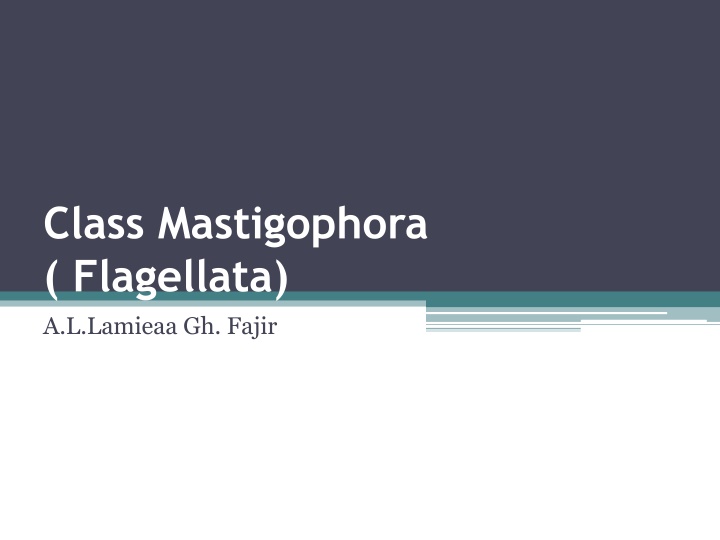
Introduction to Flagellated Protozoa and Parasites in Humans
Explore the world of flagellated protozoa and common parasites infecting humans, including Giardia lamblia and Chilomastix mesnili. Learn about their general characteristics, classification, habitat, diagnosis, and transmission methods. Dive into the intricate life cycles and unique features of these microscopic organisms.
Download Presentation

Please find below an Image/Link to download the presentation.
The content on the website is provided AS IS for your information and personal use only. It may not be sold, licensed, or shared on other websites without obtaining consent from the author. If you encounter any issues during the download, it is possible that the publisher has removed the file from their server.
You are allowed to download the files provided on this website for personal or commercial use, subject to the condition that they are used lawfully. All files are the property of their respective owners.
The content on the website is provided AS IS for your information and personal use only. It may not be sold, licensed, or shared on other websites without obtaining consent from the author.
E N D
Presentation Transcript
Class Mastigophora ( Flagellata) A.L.Lamieaa Gh. Fajir
General characteristics: 1) Motility is by flagella. The flagellum arises from kinetoplast. The kinetoplast is composed of the blepharoplast and the parabasal body. 2) Vesicular nucleus with central karyosome. 3) Reproduction is by longitudinal binary fission. 4) Complex life cycles include alternation of hosts. Intermediate hosts commonly serve as vectors, which transport developing parasites from one definitive host to another.
Classification : The flagellates protozoa that are parasites of human including: 1-Flagellates of digestive tract and genital organs such as: Flagellates of digestive tract: -Giardia lamblia , -Chilomastix mesnili , -Trichomonas hominis. -Trichomonas tenax. Flagellates of genital organs: -Trichomonas vaginalis. 2- Flagellates of blood and tissue: -Leishmania sp. -Trypanosoma sp.
Giardia lamblia Giardia lamblia is a flagellated protozoan parasite that colonises and reproduces in the small intestine, causing giardiasis (lambliasis). Trophozoite : Giardia trophozoites are pear-shaped or balloon shape and measure 10-20 m in length. In permanent, stained specimens, 2 large nuclei are usually visible. The sucking disks (used for attaching to the host s mucosal epithelium), median bodies, and flagella (8) may also be seen
habitat: the small intestine (duodenum) and gall- bladder. Diagnosis: the diagnosis is based in recovery of typical cyst and less frequently the trophozoite in the stool. Transmission: faecal-oral (alimentary). Infective stage: cyst.
Chilomastix mesnili Chilomastix mesnili is a nonpathogenic intestinal commensal of humans. This parasite is found in the large intestine( colon). Trophozoite : 8- 15 m length broadly wide anterior a sharply pointed posterior end one large nucleus three free flagella, two short and one long mouth opening ---cytosome two stiff internal flagella embedded in the cytosome
Cyst: 7- 10 m length lemon shaped one nucleus thickening in the anterior part ( knob).
Trichomonas tenax Trichomonas. hominis Trichomonas vaginalis Vagina and urethra Habitat mouth Large intestine Size (length) 7-23 m 5-12 m 5-15 m Number Anterior flagella Usually 4 (3-5) (4-5) Usually 5 (3-4) Posterior flagella Extend posteriorly beside the costa Extend posteriorly beside the costa Extend on the free margin of undulating membrane cytosome slit-like Narrow(small) Wide Undulating membrane of the body length 2/3 of the body length Full body length with free trailing flagellum Cytoplasmic metachromatic granules Coarse, aggregated around the undulating membrane & costa Well-developed Fine & scattered Fine & scattered Para basal body Faintly stained lacking pathogenisity Pathogenic (Trichomoniais) commensal ----
